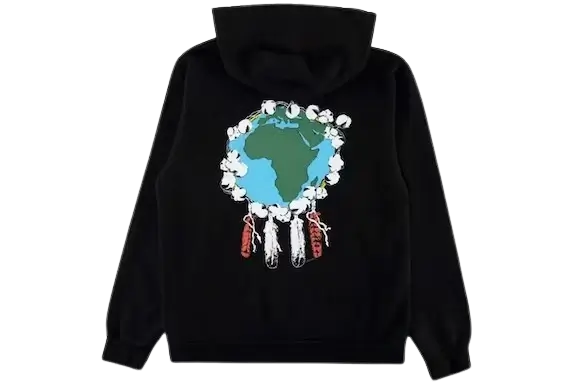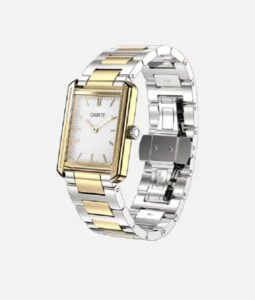In an industry as vast and dynamic as fashion, it takes something truly unique to stand out. Denim Tears a brand founded by creative visionary Tremaine Emory in 2019, is one of those rare entities that transcends the commercial to speak deeply to culture, identity, and history. By blending fashion with bold socio-political statements, particularly about African American history, Denim Tears is more than a brand—it’s a movement. Its iconic pieces—most notably, its cotton wreath-adorned denim—have become symbols of storytelling, activism, and style all in one.
The Origins: Tremaine Emory’s Vision
Tremaine Emory, the creative mind behind Denim Tears, is no stranger to fashion and culture. Having worked with giants like Marc Jacobs and Kanye West’s Yeezy line, Emory built a reputation for himself in creative circles long before launching Denim Tears. Yet, it was through his own venture that he could fully explore the themes that mattered most to him.
Born in Atlanta and raised in Queens, New York, Emory’s upbringing gave him a unique perspective on Black identity, culture, and the legacy of the African diaspora. Denim Tears, in many ways, reflects his personal journey. The brand is an expression of Black identity and resilience, a form of cultural resistance that ties together fashion, art, and history. The name “Denim Tears” itself evokes both the pain and strength of Black history, particularly the history of slavery and oppression in America.
Denim Tears’ most iconic and talked-about piece—the cotton wreath-decorated Levi’s 501 jeans—perfectly encapsulates this ethos. The cotton plant, a historical symbol of slavery and exploitation in the American South, is reappropriated by Emory to tell the story of African American resilience and survival. His work urges consumers to not only wear clothing but to wear history, to confront uncomfortable truths about the past, and to challenge the systems of oppression that continue today.
A Symbolic Reimagining of Denim
Denim has always been a fabric tied to the working class. Its roots in American labor history make it the perfect canvas for Denim Tears Hoodie to tell stories of African American labor, especially in the context of the South during the period of slavery and post-Reconstruction sharecropping. Emory’s decision to collaborate with Levi’s, the quintessential American denim brand, was no coincidence. Levi’s is a company deeply embedded in American culture, and through Denim Tears, Emory reframes that relationship by connecting it to Black American experiences.
The most iconic design in the Denim Tears line is, of course, the 501 jeans with embroidered cotton wreaths. These jeans challenge conventional fashion narratives, making a direct connection to the African American experience. The cotton motif is not just a design flourish but a loaded symbol—a reminder of slavery, forced labor, and economic inequality. Yet Emory reclaims that history through these garments, turning the painful symbol of cotton into a form of cultural pride and empowerment. By wearing Denim Tears, the consumer participates in an act of historical acknowledgment and reclamation.
The use of denim, and more specifically Levi’s denim, is central to the story that Emory is telling. Levi’s jeans were historically worn by laborers, including African Americans who worked in fields and factories. By placing cotton wreaths on these garments, Emory flips the narrative, highlighting the deep connections between Black labor and American industrial and agricultural history.
Collaborations and Cultural Impact
Denim Tears quickly gained attention for its powerful designs and storytelling, attracting collaborations with major brands and artists alike. In 2020, the brand collaborated with Converse to release a line of sneakers featuring Emory’s signature cotton motif. Like the denim pieces, these sneakers combined style with political commentary, using fashion to shine a light on America’s history of racial injustice.
Another major collaboration was with Virgil Abloh’s Off-White. The two designers shared a close friendship and a mutual understanding of the importance of using their platforms to address social and political issues. The Denim Tears x Off-White collaboration featured pieces that were rich with symbolism, often incorporating images of African American figures and nods to the Black Power movement.
Denim Tears has also partnered with Stüssy, one of the most iconic streetwear brands, further bridging the gap between high fashion and street culture. These collaborations reflect Emory’s philosophy of blending art, fashion, and activism, appealing to a wide range of consumers who are not just interested in clothing but in the cultural conversation surrounding it.
Beyond collaborations, the cultural impact of Denim Tears is seen in how the brand is worn by artists, activists, and public figures. Celebrities like Kanye West, A$AP Rocky, and Virgil Abloh himself have been spotted wearing Denim Tears, amplifying the brand’s message and significance. For many of its wearers, Denim Tears is not just another clothing line—it’s a way to participate in a dialogue about race, identity, and history.
Fashion as Activism
What sets Denim Tears apart from many other streetwear or fashion brands is its direct engagement with issues of race, identity, and history. Emory is clear about the fact that Denim Tears is not just a fashion brand—it’s a tool for activism and education. In interviews, he has emphasized that the brand is not about profit but about creating something meaningful that tells a story.
The story that Denim Tears Jacket tells is deeply rooted in the history of the African diaspora, particularly in the context of American slavery and its lasting legacy. By placing symbols like cotton front and center in his designs, Emory forces consumers to confront the uncomfortable realities of this history. In a world where fashion often shies away from political engagement, Denim Tears dives headfirst into these issues, making it one of the most unique and impactful brands of its time.
This approach aligns with the growing trend of fashion brands using their platforms to address social issues. In recent years, the fashion industry has seen a surge in activism, with brands like Telfar, Pyer Moss, and Fear of God also championing Black identity and empowerment through their designs. Denim Tears stands out in this landscape for its ability to seamlessly blend fashion with history, art, and activism, creating pieces that are as intellectually stimulating as they are stylish.
The Role of Storytelling in Fashion
At the core of Denim Tears is the idea of storytelling. For Emory, fashion is a medium through which stories can be told, and the stories he tells are deeply personal and political. Each piece from Denim Tears is a visual narrative that connects the past to the present, inviting the wearer to engage with history in a tangible way.
For example, the cotton wreath symbol is a recurring motif in Denim Tears collections, not just as a fashion statement but as a way to invoke the memory of slavery and the legacy of cotton production in the U.S. This approach speaks to the power of fashion as a form of cultural storytelling. Unlike traditional methods of learning history, fashion allows individuals to embody these narratives, carrying them into the world in a way that sparks conversation and awareness.
Emory has stated that his inspiration comes from artists, historians, and thinkers who have explored the African American experience. Denim Tears draws heavily from the work of people like James Baldwin, Toni Morrison, and Romare Bearden, all of whom used their respective mediums to explore the complexities of Black identity in America. By translating these ideas into fashion, Emory makes these themes accessible to a new generation of consumers, many of whom may not have encountered these stories in a more traditional academic setting.
The Future of Denim Tears
As Denim Tears continues to grow, its impact on fashion and culture will only deepen. Emory has made it clear that he intends to continue using the brand as a platform for cultural critique and historical storytelling. In a world where fast fashion often prioritizes profit over meaning, Denim Tears offers something different—clothing that speaks to the wearer’s identity, history, and values.
The future of Denim Tears likely involves more collaborations, more thought-provoking designs, and a continued commitment to social activism. As the fashion world becomes more politically engaged, brands like Denim Tears will play an increasingly important role in shaping the cultural narrative. Whether through new collections, art exhibitions, or community projects, Tremaine Emory’s Denim Tears will undoubtedly remain at the forefront of the conversation about fashion’s role in social justice.
Conclusion
Denim Tears is more than a clothing brand—it’s a cultural artifact that tells the story of Black resilience, history, and identity. Through bold designs, deep symbolism, and meaningful collaborations, Tremaine Emory has created a brand that is both fashion-forward and socially conscious. Denim Tears Tracksuit asks its audience not just to wear its garments but to engage with the history they represent. In doing so, it has become one of the most important and impactful brands of its time, reshaping the way we think about the intersection of fashion and activism.











